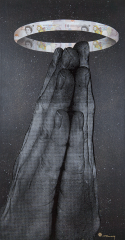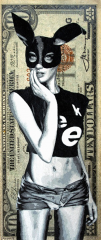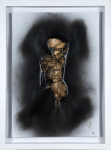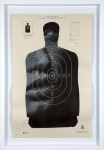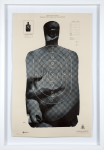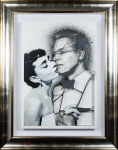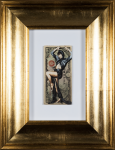Penny
*1982 London
When and where did you get into street art?
Penny: My first memory of street art was in Kent when I was 3. I chewed up a full set of Crayons that I got for a birthday present and spat them out onto the pavement. It’s still one of my favorite and most thought provoking pieces to date. You could say I peeked too early.
How would you describe street art now in your home city?
Penny: The street art in London is really diverse. It’s not just your standard lateral paintings on vertical 2D planes, it’s a lot more organic and edgy than that now. There’s a graff artist that paints landscapes on bees, he’s even released a street art honey that is actually really tasty. Another artist literally steals walls, grinds them into powder and uses it a pigment in his paintings for the perfect brick colour. The scene is really being pushed forward here.
What makes stencils stand out from other techniques?
Penny: The first stencil I cut was in 2001 when I was at Central Saint Martins doing a graphic design degree. I was so poor at the time that whenever we got a project I would always try to work out the cheapest possible way to do it. Most of the time that meant making my course work out of paper, masking tape and found items. That was usually nothing more exciting than cardboard boxes, scrap wood or defunct machinery that I found in skips. A break though moment happened when I found a few cans of car paint in a cupboard under the stairs in my flat and thought to myself, “that’s gonna save money on printing costs!” I started to use stencilling for almost every single project after that. I started off by cutting text for large format posters until I eventually cut much smaller type and from there went on to cut stencils for pictures. It was very limited at the time and I learnt as I went along, making mistakes and correcting them, thinking up new techniques for specific problems. That was the fun and the beauty of it — I loved the limitations, the limitations gave me a kind of freedom. I know that sounds like an oxymoron but having to find a solution to a visual brief with a limited palette of materials was very exciting. Each project brought new challenges and I tried to find a way to push myself with each stencil by making it more complicated or more detailed, or much smaller, I was always trying to improve from the last stencil. It has taken me on a journey that I’m still on today.
How did you develop your technique?
Penny: Over the years I have developed a few different techniques that are suitable for different outcomes. They all involve me sitting down and spending many hours cutting the stencils out of paper by hand with a scalpel. They mainly consist of two main disciplines, multi-layer and halftone. There are sub-category techniques within both of those but those two will do for now. Initially I found that I could get the most detail into an image by using the multi-layer technique. That process starts with creating an image, it might be something that I’m going to be cutting out for a few months, so I make sure that it’s an image that I’m happy to spend that sort of time on. It kind of works as a self editing process too, you don’t want to spend every waking hour on an image you think is only okay, you’ll never finish it, so you make sure you love the image before you start cutting. I separate my image into different tonal gradients and/or colours to be cut out separately. The whole time you’re doing this you’ve got to add in bridges. That’s what makes a stencil a stencil, the bridges hold the floating islands of negative space together and give a stencilled image it’s distinctive style. Once they are all cut you spray paint each stencil layer by layer maintaining perfect registration to create the image. It’s like a very laborious version of screen printing.
I found that multi-layer stencils weren’t appropriate for all types of projects and had to figure out a new method. I wanted to paint my super complicated and detailed images in the street (without permission/the fun way) and painting ten layers on to a wall was going to take too much time. On my travels around London I saw a garage that had been broken into, the door was really buckled and dented and I thought it would fit really well with an image of a man being punched in the face. I took a photo of the garage door, measured it up and went back to the studio to create the image and figure out a way of painting it exactly as I imaged it to be. This is how I got into cutting halftone stencils. Halftone images are how photos in newspapers used to be printed, they are made up of black dots, or lines, that are either large in darker areas of an image or very small in light areas. I knew it would mean spending hundreds of hours cutting out all of the tiny holes, but on the plus side I would be able to paint it very quickly. I printed out the halftone image in A3 sections and taped them all together. It’s took about 7 weeks to cut and 5 minutes to paint. The plan had worked and I was hooked! I have since tried to push the detail as far as I can go and I’m still surprising myself with how much more detail I can get from tiny cutting holes in paper.
Tell us about the work you feature in this exhibition.
Penny: Most of the works are from 2012 and are pieces from editions that have sold out that I have kept back for myself. I thought it would be good to show them again to a new audience abroad and give people another chance to buy a piece that they may have missed out on when first released
What topics does your work feature?
Penny: Painting on money, for me, has a parallel with painting in the street — in the minds of some it’s destroying something, ruining a perfectly decent surface, bringing down the tone of an area. For others it’s about transforming something redundant into something beautiful, or at the very least intriguing, something to start a conversation, make people stop and think for a second. I think it’s that feeling of taboo, that it isn’t legal. They both have that in common. Like painting on an interesting wall of surface in the city. They act as a background to give context to an image, and also inspire the image in the first place. People have a constant love/hate relationship with money, it signifies so many things about nations and their past that it’s such a rich source of inspiration for me. It’s like having walls throughout history at your fingertips, ready and waiting to be sprayed.
Describe your art with four words.
Penny: Hand-cut with scalpel.
Who/what is your source of inspiration?
Penny: I’ve always been a big admirer of Chuck Close, I was blown away by his precision, detail and the laborious nature of his work when I first saw it as a teenager. It was great for me to see someone that used as rigid a process as he does and for the finished pieces to still have such feeling and depth. There is a great quote of his that has always stuck with me, he said, “Inspiration is for amateurs. The rest of us just show up and get to work. If you wait around for the clouds to part and a bolt of lightening to strike you in the brain, you are not going to make an awful lot of work. All the best ideas come out of the process; they come out of the work itself.” The work is my motivation too, I’m obsessed with the challenge of working around problems, producing complicated and delicate images from cumbersome and basic tools and enjoying the doing rather than obsessing with being the finished article.
Where will Street/Urban Art be in the next ten years?
Penny: In ten years time there will be a resurgence of 80’s style graffiti and whole cycle will start over again.
Where will you exhibit your work next / What are your next projects?
Penny: I will be showing in LA in October and Sydney shortly after that. I am also planning my next big solo show in London for May 2014…. I will be having a couple of online releases too, so if you are interested in that you can join my paining list here –
www.onepennypiece.com
9. What else do you enjoy doing when you’re not working on your art?
Penny: errrm…. sleeping and eating!
When and where did you get into street art?
My first memory of street art was in Kent when I was 3. I chewed up a full set of Crayons that I got for a birthday present and spat them out onto the pavement. It’s still one of my favorite and most thought provoking pieces to date. You could say I peeked too early.
How would you describe street art now in your home city?
The street art in London is really diverse. It’s not just your standard lateral paintings on vertical 2D planes, it’s a lot more organic and edgy than that now. There’s a graff artist that paints landscapes on bees, he’s even released a street art honey that is actually really tasty. Another artist literally steals walls, grinds them into powder and uses it a pigment in his paintings for the perfect brick colour. The scene is really being pushed forward here.
What makes stencils stand out from other techniques?
The first stencil I cut was in 2001 when I was at Central Saint Martins doing a graphic design degree. I was so poor at the time that whenever we got a project I would always try to work out the cheapest possible way to do it. Most of the time that meant making my course work out of paper, masking tape and found items. That was usually nothing more exciting than cardboard boxes, scrap wood or defunct machinery that I found in skips. A break though moment happened when I found a few cans of car paint in a cupboard under the stairs in my flat and thought to myself, “that’s gonna save money on printing costs!” I started to use stencilling for almost every single project after that. I started off by cutting text for large format posters until I eventually cut much smaller type and from there went on to cut stencils for pictures. It was very limited at the time and I learnt as I went along, making mistakes and correcting them, thinking up new techniques for specific problems. That was the fun and the beauty of it — I loved the limitations, the limitations gave me a kind of freedom. I know that sounds like an oxymoron but having to find a solution to a visual brief with a limited palette of materials was very exciting. Each project brought new challenges and I tried to find a way to push myself with each stencil by making it more complicated or more detailed, or much smaller, I was always trying to improve from the last stencil. It has taken me on a journey that I’m still on today.
How did you develop your technique?
Over the years I have developed a few different techniques that are suitable for different outcomes. They all involve me sitting down and spending many hours cutting the stencils out of paper by hand with a scalpel. They mainly consist of two main disciplines, multi-layer and halftone. There are sub-category techniques within both of those but those two will do for now. Initially I found that I could get the most detail into an image by using the multi-layer technique. That process starts with creating an image, it might be something that I’m going to be cutting out for a few months, so I make sure that it’s an image that I’m happy to spend that sort of time on. It kind of works as a self editing process too, you don’t want to spend every waking hour on an image you think is only okay, you’ll never finish it, so you make sure you love the image before you start cutting. I separate my image into different tonal gradients and/or colours to be cut out separately. The whole time you’re doing this you’ve got to add in bridges. That’s what makes a stencil a stencil, the bridges hold the floating islands of negative space together and give a stencilled image it’s distinctive style. Once they are all cut you spray paint each stencil layer by layer maintaining perfect registration to create the image. It’s like a very laborious version of screen printing.
I found that multi-layer stencils weren’t appropriate for all types of projects and had to figure out a new method. I wanted to paint my super complicated and detailed images in the street (without permission/the fun way) and painting ten layers on to a wall was going to take too much time. On my travels around London I saw a garage that had been broken into, the door was really buckled and dented and I thought it would fit really well with an image of a man being punched in the face. I took a photo of the garage door, measured it up and went back to the studio to create the image and figure out a way of painting it exactly as I imaged it to be. This is how I got into cutting halftone stencils. Halftone images are how photos in newspapers used to be printed, they are made up of black dots, or lines, that are either large in darker areas of an image or very small in light areas. I knew it would mean spending hundreds of hours cutting out all of the tiny holes, but on the plus side I would be able to paint it very quickly. I printed out the halftone image in A3 sections and taped them all together. It’s took about 7 weeks to cut and 5 minutes to paint. The plan had worked and I was hooked! I have since tried to push the detail as far as I can go and I’m still surprising myself with how much more detail I can get from tiny cutting holes in paper.
Tell us about the work you feature in this exhibition.
Most of the works are from 2012 and are pieces from editions that have sold out that I have kept back for myself. I thought it would be good to show them again to a new audience abroad and give people another chance to buy a piece that they may have missed out on when first released
What topics does your work feature?
Painting on money, for me, has a parallel with painting in the street — in the minds of some it’s destroying something, ruining a perfectly decent surface, bringing down the tone of an area. For others it’s about transforming something redundant into something beautiful, or at the very least intriguing, something to start a conversation, make people stop and think for a second. I think it’s that feeling of taboo, that it isn’t legal. They both have that in common. Like painting on an interesting wall of surface in the city. They act as a background to give context to an image, and also inspire the image in the first place. People have a constant love/hate relationship with money, it signifies so many things about nations and their past that it’s such a rich source of inspiration for me. It’s like having walls throughout history at your fingertips, ready and waiting to be sprayed.
Describe your art with four words.
Hand-cut with scalpel.
Who/what is your source of inspiration?
I’ve always been a big admirer of Chuck Close, I was blown away by his precision, detail and the laborious nature of his work when I first saw it as a teenager. It was great for me to see someone that used as rigid a process as he does and for the finished pieces to still have such feeling and depth. There is a great quote of his that has always stuck with me, he said, “Inspiration is for amateurs. The rest of us just show up and get to work. If you wait around for the clouds to part and a bolt of lightening to strike you in the brain, you are not going to make an awful lot of work. All the best ideas come out of the process; they come out of the work itself.” The work is my motivation too, I’m obsessed with the challenge of working around problems, producing complicated and delicate images from cumbersome and basic tools and enjoying the doing rather than obsessing with being the finished article.
Where will Street/Urban Art be in the next ten years?
In ten years time there will be a resurgence of 80’s style graffiti and whole cycle will start over again.
Where will you exhibit your work next / What are your next projects?
I will be showing in LA in October and Sydney shortly after that. I am also planning my next big solo show in London for May 2014…. I will be having a couple of online releases too, so if you are interested in that you can join my paining list here –
www.onepennypiece.com
9. What else do you enjoy doing when you’re not working on your art?
errrm…. sleeping and eating!








